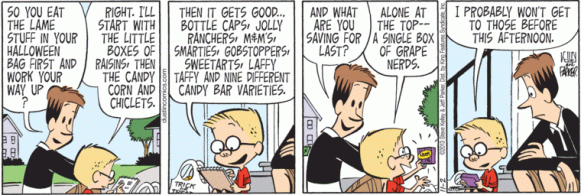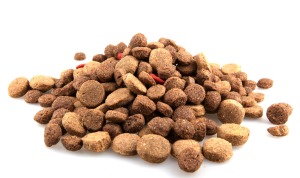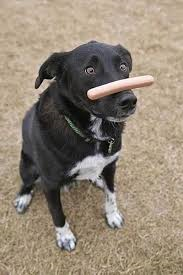Like kids with their Halloween candy, do dogs rank the treats that we provide to them? Many trainers selectively use what we call “high-value treats” for some behaviors and “low-value treats” for others. However, other than subjectively observing the level of our dog’s pleasure at receiving different types of treats, do we have actual evidence that treats vary in their influence upon learning? For example, does my Chippy learn faster or more efficiently when I use homemade tuna treats versus small, dry biscuits? Intuitively, I think that he does, since he almost climbs into the oven when he smells his treats baking (the only thing I am even remotely capable of producing in the kitchen, by the way).
 HMMMM…….I DO LIKE MOM’S TUNA TREATS…
HMMMM…….I DO LIKE MOM’S TUNA TREATS…
Lucky for us, some scientists have already asked this question and are providing some answers.
The Study: Mariana Bentosela and her co-investigators trained a group of 13 adult (pet) dogs to offer eye contact using either a high incentive treat (dried liver pieces), or a low incentive treat (dry kibble pieces) as the positive reinforcer. The methods used to train this behavior are the same used in the study that I reviewed in the “Trick or Treat” blog of October 31. All of the dogs rapidly learned “gazing behavior” using both types of reinforcer and all consumed the treats that were provided, regardless of the type. Following the initial acquisition phase, dogs were rested for one hour and a second training session was conducted. In the second session, training was exactly the same, except that all of the dogs now received dry dog food pieces as reinforcers. The investigators refer to this as “downshifting” the dogs who had been previously trained using liver treats. In this study, the dogs who were trained in both sessions with dry kibble are the control group. Behaviors that were measured included the number of trials to acquisition, gaze duration, food rejection, and general behavior and communication signals.
DRIED LIVER (HIGH INCENTIVE) DRY DOG FOOD (LOW INCENTIVE)
Study Results: The researchers were interested in finding out if dogs, like several other mammals, would react to a change from a high-value to a low-value reinforce with a behavior that was initially taught using the high-value treat. Here is what they found:
- During the initial training phase, although all of the dogs learned to offer gaze, dogs trained using the high-value treat maintained eye contact for a significantly longer duration than did dogs trained using the low-value treat (23.1 vs. 15.7 seconds, respectively).
- During the second phase, dogs who were downshifted from liver to kibble rapidly decreased their gaze duration, while the control dogs who had been offered kibble in both trials showed an increase in gaze duration.
-
Dogs who had been trained with liver and then switched to kibble rejected the food on significantly more occasions when offered kibble than did dogs who were trained consistently with the kibble pieces. Most commonly, the dog would approach the treat being offered, sniff the treat in the trainer’s hand, and then walk away without eating it.
Take Away for Dog Folks: First, we must note that the study groups used in this experiment were quite small (6 dogs in the control group and 7 dogs in the experimental group), and that the behavior that was trained is very simple and is easily acquired by most dogs. However, even with these limitations, the results suggest that learning is influenced by the value of the positive reinforcer that is used and that dogs are affected by changes in anticipated reinforcer value. Dogs trained with high-value treats showed a stronger response (longer duration of gaze), but also demonstrated signs of extinction when suddenly switched to a low-value treat and even rejected the reinforcer!
Most trainers who pay attention to different value reinforcers use high-value treats when training a difficult or complex behavior. Typically, we pair high-value treats with the behavior that is most difficult or the part of a sequence that the dog is least motivated to offer. (If back-chaining, the last behavior gets the highest value treat). The results of this study tell us that, yes, using a variety of treat types can be helpful, and that yes, high value treats may enhance learning. However, the results also suggest that we might want to pay close attention to downshifting from high to lower value treats during training sessions. Dogs may not only notice the switch, but it can affect the stability of a previously trained behavior, at least when that behavior has been only recently learned and is not yet reliable.
So trainers – Continue to rank your treats and pay careful attention to the value that they have to your dog, both when you are using the high-value stuff and when you throw in that handful of dried kibble or biscuits now and then. Happy Training!
WILL WORK FOR HOT DOG.
Reference: Bentosela, M, Jakovcevic A, Elgier AM, Mustaca AE, Papini MR. Incentive contrast in domestic dogs (Canis familiaris). Journal of Comparative Psychology 2009; 123:125-130.




Did the study explain if the dogs were also being their normal meals and what those meals were? Such an interesting topic, I’ve resorted to a sort of Sophia Yin method of measuring out the dog’s kibble in the morning, and then giving it to him throughout the day (usually on walks) either as reward for training or stuffed into enrichment toys. He seems treat this kibble like a high valued liver with this method.
He does still get the odd bit of leftover egg, meat, banana etc. but he still treats his kibble with a high value when dished out in the manner described above.
Sometimes when I’m busy, and place the food into his bowl at breakfast time (as I won’t have time to dish the food out as rewards) he doesn’t even bother to eat it!
All very interesting.
LikeLike
Hi Erin, Thanks for your comment! The dogs were all being fed normally but had not had a meal for at least 8 hours prior to the training sessions. I agree that providing food in a variety of enrichment toys and via training is a great approach for a lot of dogs (especially those who are predisposed to weight gain!). I think it is especially interesting that your dog shows enhanced interest when his kibble is fed to him in a toy or as part of training and ignores the same exact food when it is in his bowl. That would be a great topic to study in a group of dogs, and one that I do not think has been conducted yet.
LikeLike
I compare food rewards to dogs to paychecks for people. If a person was asked to do the same job with a cut in pay they would not be as motivated as they were previously. The value of the reinforcer is determined by the dog – it is only valuable if they think it is. I think that if we ask them to do a more difficult task we should pay them better. I always recommend a “jackpot” (bonus) for training a reliable recall. (Max thinks warm hot dog bits or real chicken pieces trump everything else going on.)
LikeLike
Hi Linda – Excellent analogy! It would be interesting to see a study of using jackpots, as they definitely are used a lot and there is evidence that dogs visually discriminate between small and large amounts of food! Thanks for the comment!
LikeLike
I think a jackpot can be a higher-value food not just a higher quantity. One piece of hot dog is better than 6 pieces of kibble to Max! lol
LikeLike
I have read that giving Jackpots is actually counter productive.
Apparently, rather than increase the likelihood of he behaviour being repeated or increase the enthusiasm with which it is performed, jackpots actually lower it.
I cannot find he reference at the moment but this refers to the same problem
Click to access thesis.pdf
I always reward lavishy AFTER a training session has ended — most often with either a ball game or “Bone time”. This seems to work by increasing the dogs’ desire to work during the training session.
If I feel the need to Jackpot something then I do so, and end the actual training session. I do not asl for any more anything in that session 🙂
LikeLike
http://www.sciencedaily.com/releases/2012/07/120710093802.htm
Multiple Pieces of Food Are More Rewarding Than an Equicaloric Single Piece of Food in Both Animals and Humans
LikeLike
Reblogged this on Wolf Is My Soul.
LikeLike
Thanks for the reblog!
LikeLike
I like to make sort of a doggy trail mix, a mixture of high, medium and lower value treats, to keep the dog guessing.
LikeLike
Pingback: Treat Tips for Trainers – The Science Dog
Pingback: Taste Tests with Your Dog’s Food Toys – The Science Dog